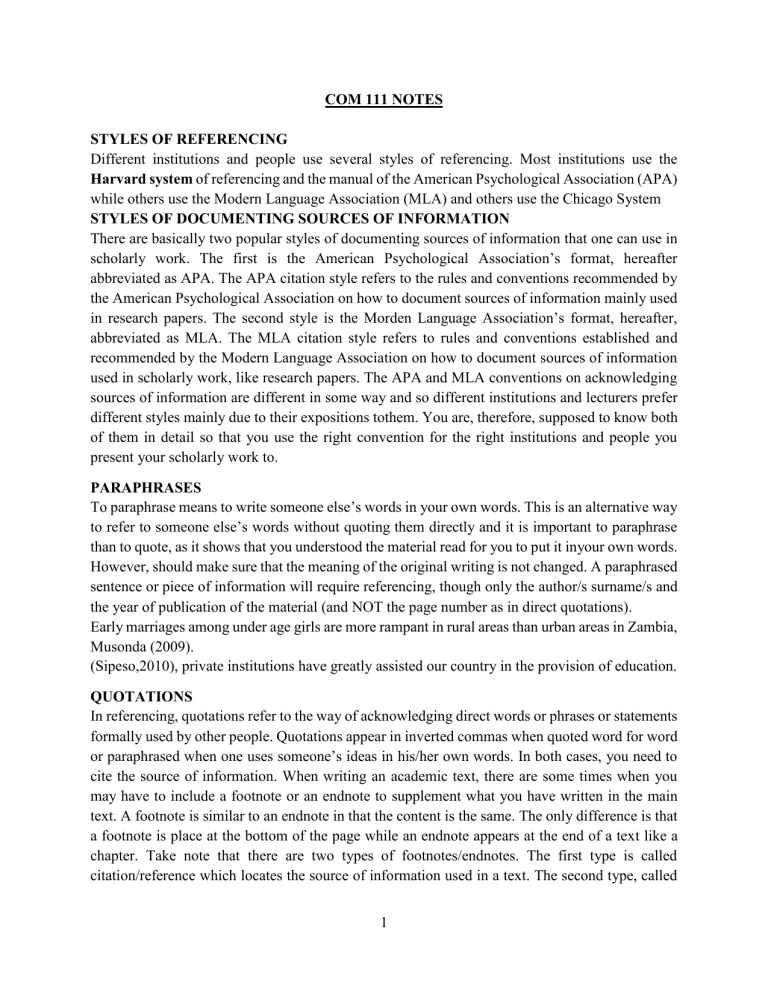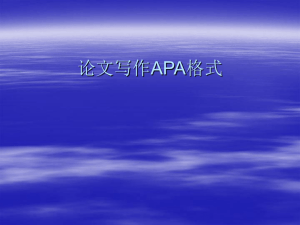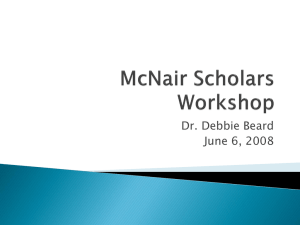
COM 111 NOTES STYLES OF REFERENCING Different institutions and people use several styles of referencing. Most institutions use the Harvard system of referencing and the manual of the American Psychological Association (APA) while others use the Modern Language Association (MLA) and others use the Chicago System STYLES OF DOCUMENTING SOURCES OF INFORMATION There are basically two popular styles of documenting sources of information that one can use in scholarly work. The first is the American Psychological Association’s format, hereafter abbreviated as APA. The APA citation style refers to the rules and conventions recommended by the American Psychological Association on how to document sources of information mainly used in research papers. The second style is the Morden Language Association’s format, hereafter, abbreviated as MLA. The MLA citation style refers to rules and conventions established and recommended by the Modern Language Association on how to document sources of information used in scholarly work, like research papers. The APA and MLA conventions on acknowledging sources of information are different in some way and so different institutions and lecturers prefer different styles mainly due to their expositions tothem. You are, therefore, supposed to know both of them in detail so that you use the right convention for the right institutions and people you present your scholarly work to. PARAPHRASES To paraphrase means to write someone else’s words in your own words. This is an alternative way to refer to someone else’s words without quoting them directly and it is important to paraphrase than to quote, as it shows that you understood the material read for you to put it inyour own words. However, should make sure that the meaning of the original writing is not changed. A paraphrased sentence or piece of information will require referencing, though only the author/s surname/s and the year of publication of the material (and NOT the page number as in direct quotations). Early marriages among under age girls are more rampant in rural areas than urban areas in Zambia, Musonda (2009). (Sipeso,2010), private institutions have greatly assisted our country in the provision of education. QUOTATIONS In referencing, quotations refer to the way of acknowledging direct words or phrases or statements formally used by other people. Quotations appear in inverted commas when quoted word for word or paraphrased when one uses someone’s ideas in his/her own words. In both cases, you need to cite the source of information. When writing an academic text, there are some times when you may have to include a footnote or an endnote to supplement what you have written in the main text. A footnote is similar to an endnote in that the content is the same. The only difference is that a footnote is place at the bottom of the page while an endnote appears at the end of a text like a chapter. Take note that there are two types of footnotes/endnotes. The first type is called citation/reference which locates the source of information used in a text. The second type, called 1 content footnote/endnote only add more information (notes) to the issues discussed in the text which if put in the main text might be not that necessary to the reader. In other words, footnotes and endnotes of this type are most often used as an alternative to long explanatory notes that could be distracting to readers. FOOTNOTE A footnote is a short piece of text, often numbered, placed at the bottom of a printed page, that adds a comment, citation, reference, etc to a designated part of the main text. END NOTE An end note is an annotation (explanatory comment) placed at the end of a document. APPENDIX An appendix is an attachment or accompaniment to an academic piece of writing e.g Research paper. The APA Style American Psychological Association (APA) style is a widely accepted style of documentation, particularly in the social sciences. APA style specifies the names and order of headings, formatting, and organization of citations and references, and the arrangement of tables, figures, footnotes, and appendices, as well as other manuscript and documentation features. APA style uses the authordate style of parenthetical referencing, with such source citations keyed to a subsequent list of "References." Also known as the Harvard Style. REFERENCING INSIDE THE TEXT Single author Format should be Author's last name followed directly by a comma, then the year of publication. When one makes the reference to the author(s) directly as a part of the narrative, then only the year (and page number if needed) would remain enclosed within parentheses. The same holds for multiple authors as you can see in the following examples. A recent study found a possible genetic cause of alcoholism (Pauling, 2005). Pauling (2005) discovered a possible genetic cause of alcoholism. Two authors Authors should be presented in order that they appear in the published article. If they are cited within closed parentheses, use the ampersand (&) between them. If not enclosed in parentheses then use expanded "and". Three to five authors With three to five authors, the first reference to an article includes all authors. Subsequent citations in the same document may refer to the article by the principal author only plus "et al." However, all authors must be present in the references section. A recent study found a possible genetic cause of alcoholism (Pauling, Liu, &Guo, 2005). Pauling, Liu, and Guo (2005) conducted a study that discovered a possible genetic cause of alcoholism. Pauling et al. (2005) discovered a possible genetic cause of alcoholism. A recent 2 study found a possible genetic cause of alcoholism (Pauling et al., 2005). Six authors or more The correct format is (First Author’s surname et al., Year). In the reference section, all six authors' names should be included. Pauling et al. (2005) discovered a possible genetic cause of alcoholism. Multiple publications, same author If an author has multiple publications that you wish to cite, you use a comma to separate the years of publication in chronological order (oldest to most recent). If the publications occur in the same year, the Publication Manual recommends using suffixes a, b, c, etc. (note that corresponding letters should be used in the reference list, and these references should be ordered alphabetically by title). Recent studies have found a possible genetic cause of alcoholism (Pauling, 2004, 2005a, 2005b). Pauling (2004, 2005a, 2005b) has conducted studies that have discovered a possible genetic cause of alcoholism Multiple publications, different authors. Follow the rules for one author above, and use a semicolon to separate articles. Citation should first be in alphabetical order of the author, then chronological. Recent studies found a possible genetic cause of alcoholism (Alford, 1995; Pauling, 2004, 2005; Sirkis,2003) Secondary referencing This is where one author is referring to the work of another and the primary source is not available. The writer should cite the primary source and the source read. Follow the rule for one or two authors: Bwalya and Pumulo 2012, cited in Chola, 2010. Phiri 2018, cited in Musgrave, 2016. Online sources When referencing a web page in the text, it should be the author’s surname and year of publication that are put in brackets and not the web page address or URL. Sometimes the author may be an organization that publishes the web page. Phiri (2009) agrees that...............or (Phiri,2009) agrees that........... According to the Department of Health (2010), the........................ DIRECT QUOTES OR CITATIONS The same rules as above apply here, the format being (Author surname, Year, Page Number). When asked why his behavior had changed so dramatically, Max simply said, "I think it's the 3 reinforcement" (Pauling, 2004, p. 69) or Pauling (2004, p. 69) or (Pauling 2004:69) or Pauling (2004:69). NB: Direct quotes can also be for one author, two authors, three or more or on line source REFERENCE LIST The APA style guide prescribes that the Reference section, bibliographies and other lists of names should be accumulated by surname first, and mandates inclusion of surname prefixes. For example, "Martin de Rijke" should be sorted as "De Rijke, M." and "Saif Al Falasi" should be sorted as "AlFalasi, S." (The preference for Arabic names now is to hyphenate the prefix so that it remains with the surname.) The title of the book should either be bolded, underlined or italised. PRINT SOURCES A] Book by one author Sheril, R. D. (1956).The terrifying future: Contemplating color television. San Diego: Halstead. B] Book by two authors or more Smith, J., and Peter, Q. (1992).Hairball: An intensive peek behind the surface of an enigma. Hamilton, ON: McMaster University Press. C] Article in an edited book Mcdonalds, A. (1993). Practical methods for the apprehension and sustained containment of supernatural entities. In G. L. Yeager (Ed.), Paranormal and occult studies: Case studies in application (pp. 42–64). London: OtherWorld Books. D) An edited book Mwansa D.M. (ed.) (2006). Study Skills for Freshers. Lusaka: ZAOU University Press. E) A chapter in a book Pelekelo, P. (1997)”Citations in the text.” In Phiri, K. et al. (eds.). Study Skills for College Students. London: Stanley Thorns. F] Article in a journal paginated separately Crackton, P. (1987). “The Loonie: God's long-awaited gift to colourful pocket change?” Canadian Change, 64 (7), 34–37. G] Article in a journal with continuous pagination Rottweiler, F. T., &Beauchemin, J. L. (1987). “Detroit and Narnia: Two foes on the brink of destruction.” Canadian/American Studies Journal, 54, 66-146. 4 H] Article in a weekly magazine 49 Clark Matt, Sharon Begley, and Mary Hager. “The Miracles of Spliced Genes,” Newsweek 17 Mar. 1980:62-71. Henry, W. A., III. (1990, April 9). Making the grade in today's schools.Time, 135, 28–31. I] Article in a newspaper Wrong, M. (2005, August 17). "Never Gonna Give You Up" says Mayor.Toronto Sol, p. 4. J] Government document Revenue Canada. (2001). Advanced gouging: Manual for employees (MP 65–347/1124). Ottawa: Minister of Immigration and Revenue. K) Editorial Editorials hve names of writers and should put title in double inverted commas, name of newspaper, date and year plus page number “Elections in Zambia.” Editorial. The Mast 5 Mar. 2018:7 L) Encyclopedias and Almanacs (signed with name or initials) Example: Allen, Fredrick G.”Leyden Jar.” Encyclopedia Americana. 1977 ed. M) Pamphlets and Bulletins Example: Safety Data Sheet-Kitchen Machines. Pamphlet 690.Chicago:Natt. Restaurant Assn., 1970. 5



